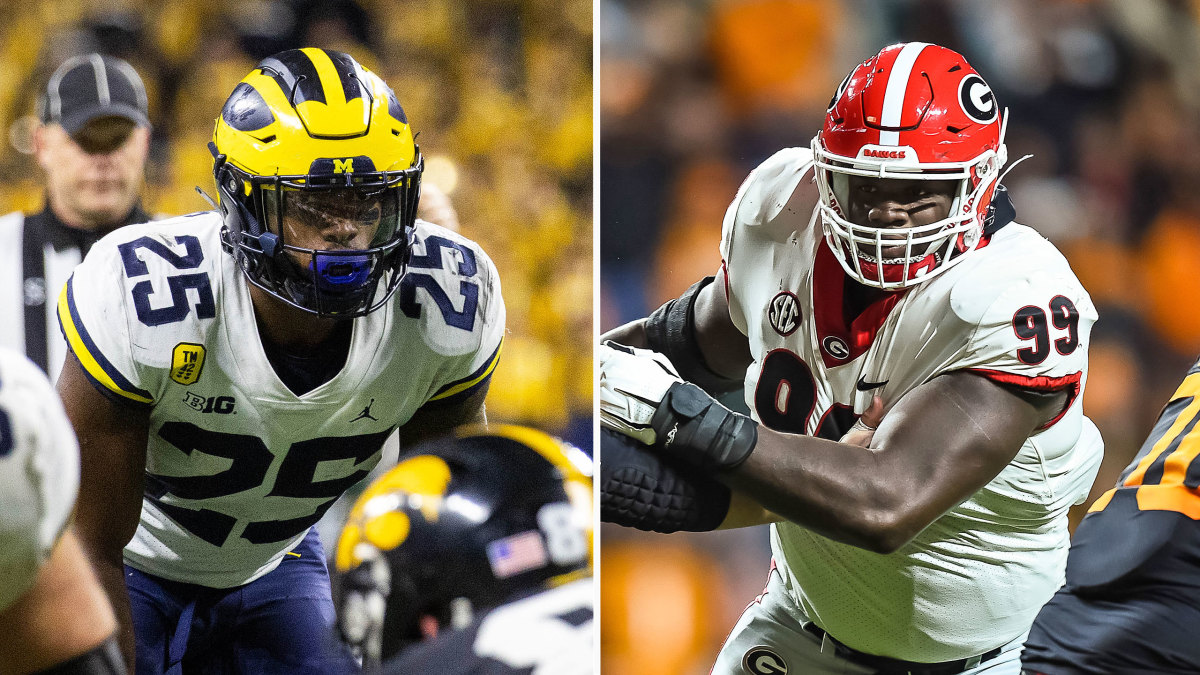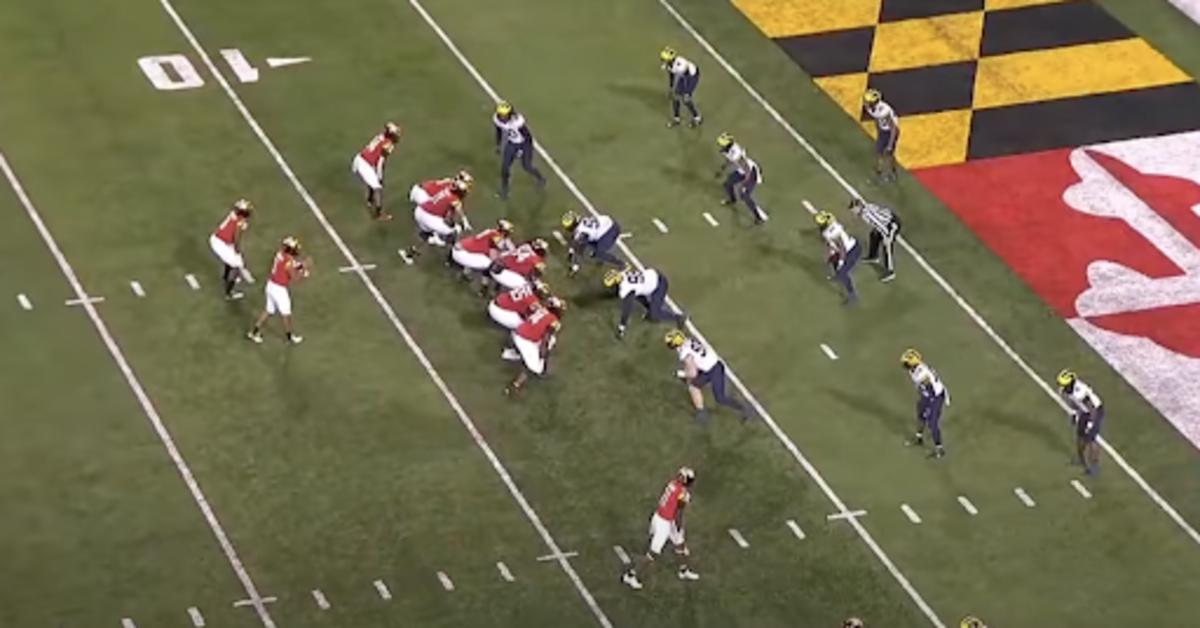Film Room: Inside the Keys to a Bruising Georgia-Michigan Matchup
On Friday night, Michigan and Georgia will set out to play the game the way it’s supposed to be played. As Georgia’s defensive coordinator put it during his Orange Bowl press conference, “Michigan plays football.”
Both these offenses have plenty of overlap in how they play on that side of the ball. But the defenses, while great, go about things in different ways.
When Michigan has the ball …
Michigan is explosive, and surprisingly so. Eight of its FBS-leading 17 plays of 50 yards or more were runs, and nine were via the pass. But Georgia has given up only five plays of that length this season, and two of them were in the SEC title game against Alabama. As far as more replicable big plays go, Michigan is 58th in passing plays of 20+ yards (42) and 18th in rushes of 20+ yards (24). Georgia leads the country in allowing the latter category (3) and is sixth in the country in the former (28). However, Alabama lays claim to seven of the 20+ yard passing plays that Georgia has allowed this season.
Michigan features good old Big Ten ground-and-pound with the two-headed monster of Blake Corum and Hassan Haskins, the former being more of the home-run hitter (6.6 yards per carry on 141 carries) and the latter being more of the workhorse (1,288 yards). Michigan’s rushing attack versus Georgia’s defense is the biggest strength-on-strength matchup in either of the College Football Playoff semifinals, considering how the Wolverines go about their business and how the Bulldogs will attempt to stop them.

On plays where Michigan has pullers—whether frontside, backside or multiple—the Wolverines are fifth in the country in attempts, per Sports Info Solutions. They run such plays nearly 40% of the time, according to Pro Football Focus. They want their beef on the move with staple plays such as a counter where two blockers pull (often the guard and the tackle or the guard and a tight end), which has powered some of the best rushing attacks in college and pro football for 50 years. It’s the bread and butter of this Joe Moore Award–winning offensive line.
It was on full display in the biggest spots for Michigan this season, including against Ohio State.
You can see from the reverse angle that Haskins simply follows left guard Trevor Keegan and tight end Erick All to paydirt against the Buckeyes. Michigan’s multiple-tight-end usage is one of its biggest differentiators in use of personnel. While high relative to the rest of the sport, it’s nearly identical to the number of times Georgia deploys multiple tight ends.
A problem Michigan may run into (literally), however, is this …
Some teams defend the counter by keeping the running back in the “box,” while others spill to have other defenders clean up with tackles in space. Georgia dispenses with those subtleties by being shockingly violent at the point of attack, setting a hard edge where coach Kirby Smart hopes his defense can “build a wall” when opponents try to run plays with pullers.
Of course, Michigan will also try to run straight ahead at UGA (it’s certainly had success doing that, too). The results on those kinds of runs may vary, considering the Dawgs’ interior defensive linemen Jordan Davis, Jalen Carter and Devonte Wyatt. The three-headed monster inside is good, but it is also fresh, with each playing only about half of Georgia’s total snaps this season due to substitution rotations. The trio lead a run defense that stops 20% of all carries against it for zero or negative yards (fourth nationally) …
While the Wolverines’ J.J. McCarthy does offer a QB run threat as a backup, Michigan’s chance at having a lot of success on offense will likely come down to starter Cade McNamara’s arm. A big day is not exactly out of the question.
Some of Michigan’s biggest plays of the year have come on in-breaking routes, like this one to Andrel Anthony from a trips bunch set that stung Michigan State.
While admittedly not the same concept, Georgia has been recently stung by a busted safety rotation from a similar three-receiver look, and it’s something the Dawgs will have to shore up. They will certainly see something similar from Michigan in the passing game.
The Wolverines are 82nd in intended air yards this season ,while Georgia is 94th; neither is a remotely vertical passing game. McNamara has thrown for over 300 yards only one time, and the 93-yarder to Anthony in the Michigan State game is the only reason he got to 383 that day. What the Wolverines do have is many tricks up their sleeve, including flea flickers, throw backs, double passes and the wheel route.
The wheel isn’t a staple of their passing game but it does provide a changeup for an offense that spends so much time playing in a phone booth. Michigan’s generated the sixth-most receiving yards from wheels this season, and even without these 77 yards, they’d still be top 25 in overall receiving yards.
If Michigan is pulling out all the stops, it may look to last season’s Florida-Georgia game for clues on how to get at the Bulldogs’ defensive structure. Or at how Kentucky’s passing game attempted to use running backs getting open on flat routes and wheels to differing effects. In the Wildcats’ 2021 game vs. Georgia, they generated a defensive pass interference on one play when they tried to pick on linebacker Quay Walker, but later in that game, Georgia was able to take it away in man coverage behind a blitz. The lesson being: If you have your shot against the Dawgs, you’d better take it and you’d better not miss.
Michigan offensive coordinator Josh Gattis, formerly Alabama’s OC and familiar with the Tide’s system, may also draw from what Bama did against the Dawgs in the SEC title game to try to generate offense against one of the best defenses in the country.
When Georgia has the ball …
Up front with Michigan’s defense, what you see is largely what you get. Where Georgia’s defensive line routinely shifts into its actual alignment split seconds before the ball is snapped, Michigan is more or less going to line up with four or five players on the line of scrimmage—two of whom (Heisman finalist Aidan Hutchinson and his fellow edge David Ojabo) will typically be standing up rather than with their hand in the dirt. The biggest difference between these two defenses is how they go about their business in rushing the passer.

Michigan’s defense is predicated on demanding that those two players simply win one-on-one matchups, and they certainly do so, with 113 QB pressures combined (including Hutchinson’s nation-leading 73 in addition to his school-record 14 sacks). In that way, Michigan emulates where defensive coordinator Mike Macdonald comes from, as the former Baltimore Ravens assistant coach is in his first year coordinating Michgan’s D.
But the Wolverines had better hope they rush soundly. Georgia quarterback Stetson Bennett has the ability to extend drives with back-breaking scrambles in addition to his credible threat in the zone-read game that, if deployed effectively, can neutralize either Hutchinson or Ojabo.
Stetson Bennett showed Saturday one way how he will punish you for little mistakes. Rush him wrong, and he's out the backdoor. pic.twitter.com/dBC8GBXVrS
— Richard🇬🇾Johnson (@RJ_cfb) November 16, 2021
Michigan doesn’t blitz all that much, only on about 30% of opponent dropbacks (down from the more aggressive Don Brown days). But what it will do is simulate pressure, lining up six on the line of scrimmage and dropping two out to try and confuse both the pass protection and the quarterback. Here, the droppers take away Wisconsin’s quick options and help give Ojabo and Hutchinson time to get home.
Dropping players into throwing lanes up front is one way to change up the picture post-snap on a quarterback. Another is to rotate in the secondary, which Michigan does about as often as Alabama does as far as snaps rotating from two safeties high pre-snap to one safety high post-snap. That will come into focus against the Georgia quarterback.
“Stetson Bennett to me is very instinctive,” Alabama coach Nick Saban said after the SEC championship game. “If he knows what the picture is, that’s when he made plays and several big plays. So, I think changing the picture on him a little bit helped.”
Projecting Georgia’s passing offense comes with numerous caveats. We’re not sure whether downfield threat George Pickens will play due to COVID-19 protocols, or even how much he will play if he does suit up, given he’s still not all that far out from a spring practice ACL injury. But if Pickens does play, he gives Bennett and the Dawgs a take-the-top-off-a-defense gear to their vertical passing game provided Bennett—who struggles with deep arm strength—can get the ball to him. It also must be noted that we still haven’t seen JT Daniels take a significant snap, and while Michigan can turn to McCarthy in a pinch to add a rushing threat, Daniels’s insertion—whether due to injury or to Bennett being benched for poor performance—could unlock a different dimension to UGA’s passing game.
Watch NCAA football games online all season long with fuboTV: Start with a 7-day free trial!
Bennett has thrown the ball more than 21 times in only two games this season. But when he does throw, the ball is likely going to tight end Brock Bowers, whose 64 targets lead the team and are nearly double anyone other than Adonai Mitchell’s 47. (As do Bowers’s 11 receiving TDs.)
Had Georgia needed to throw more in 2021, Bowers likely would have been able to generate the counting stats to impress John Mackey Award voters, but make no mistake—there are few better tight ends in the country.
A Michigan team that plays more zone defense than in recent years under Brown can be gotten at with a seam threat as good as Bowers, who can find holes in zones. And Bowers is often not lined up as an inline tight end, with half of his snaps coming either in the slot or out wide. If Pickens doesn’t play or is limited, and Bowers can be held in check (relatively), the flow of the game will determine whether Bennett will have to win this one with his arm.
Do not discount either of these teams coming out with something even more bespoke than what they’ve put on film, à la Ohio State’s tempo and formation into the boundary-heavy Sugar Bowl game plan that roasted Clemson in 2020’s semifinal. But either quarterback having the skill level to pull off a different style of game than what’s gotten both teams here isn’t likely.
We have only seen Georgia’s offense truly tested once. But if either D is successful, it can force offenses to play an uncomfortable drop-back game. It’s going to be 60 minutes of one team attempting to bludgeon the other with brute force—as throwback a style as one can ask for in pass-happy 2021. Some of it has to do with the skill of each team’s quarterbacks. Other things have to do with simply playing to the strengths of the rosters. These things should combine to produce a game you’ll want to pay attention to between the tackles more than anywhere else, because that’s where the winner will be dictated, as is so often the case. And that’s just the way both of these teams want it to be.
More College Football Coverage:
• Rick Flick Lost a Son. At Cincy, He Found New Purpose
• When Nick Saban Calls, The Wolf Answers
• Will Anderson Thinks Bama Is Underdog vs. Cincy
Sports Illustrated may receive compensation for some links to products and services on this website.
